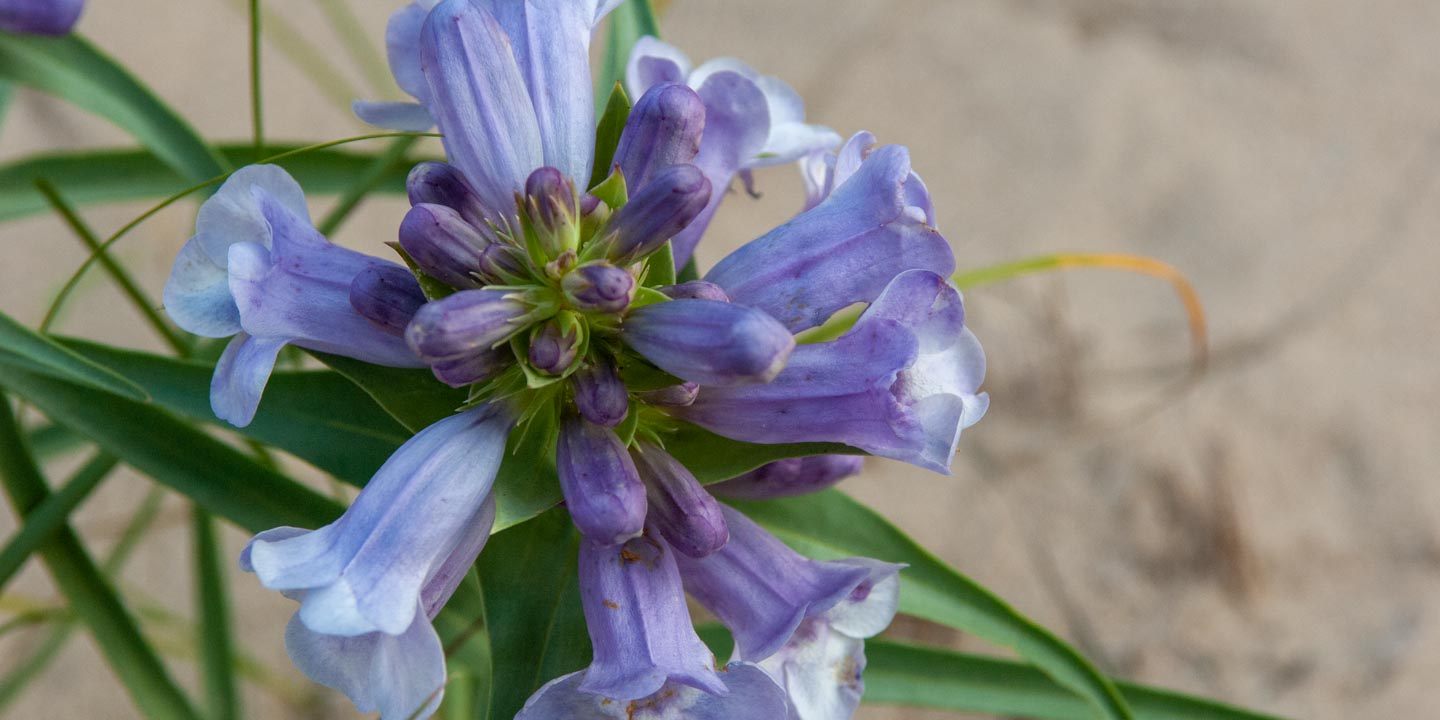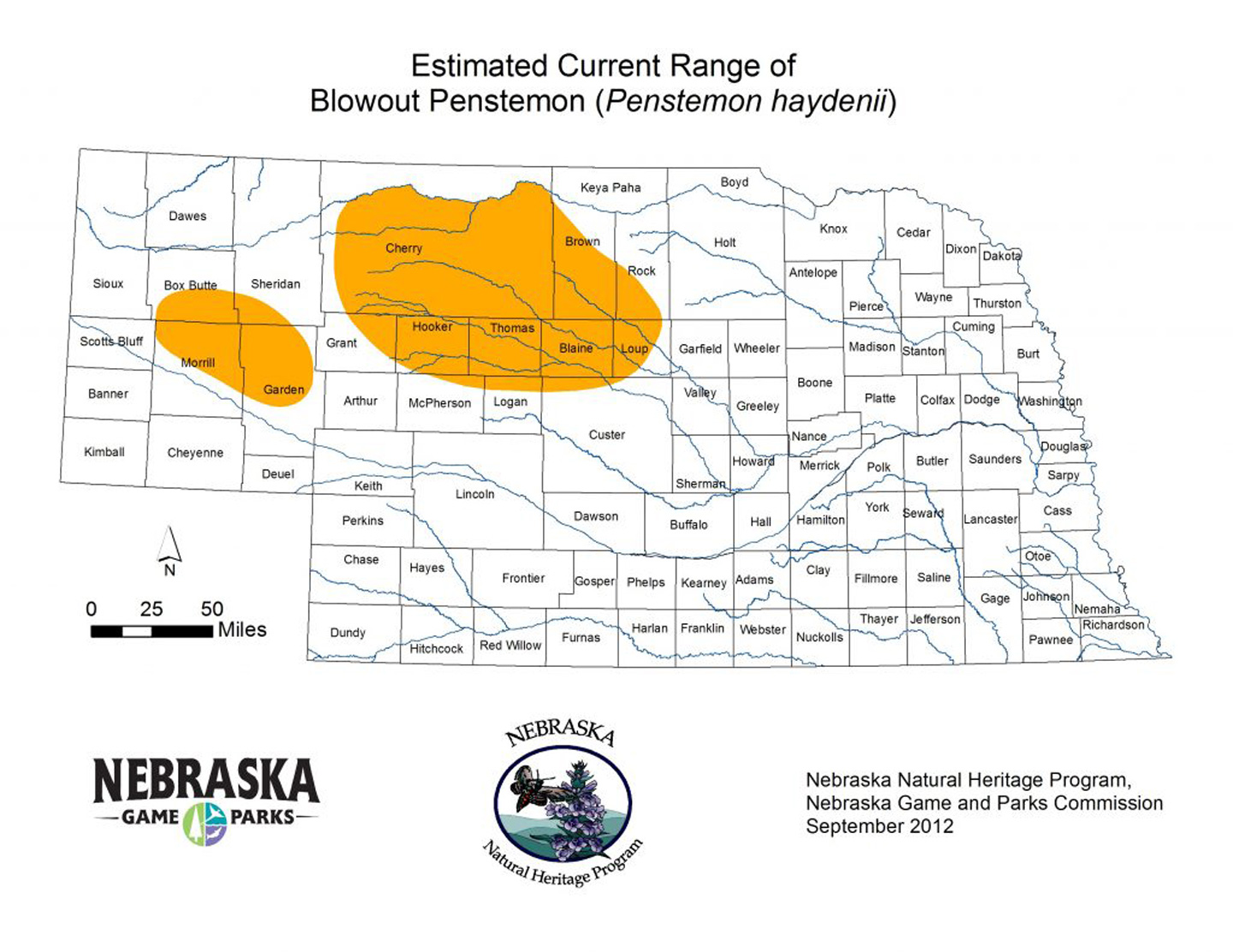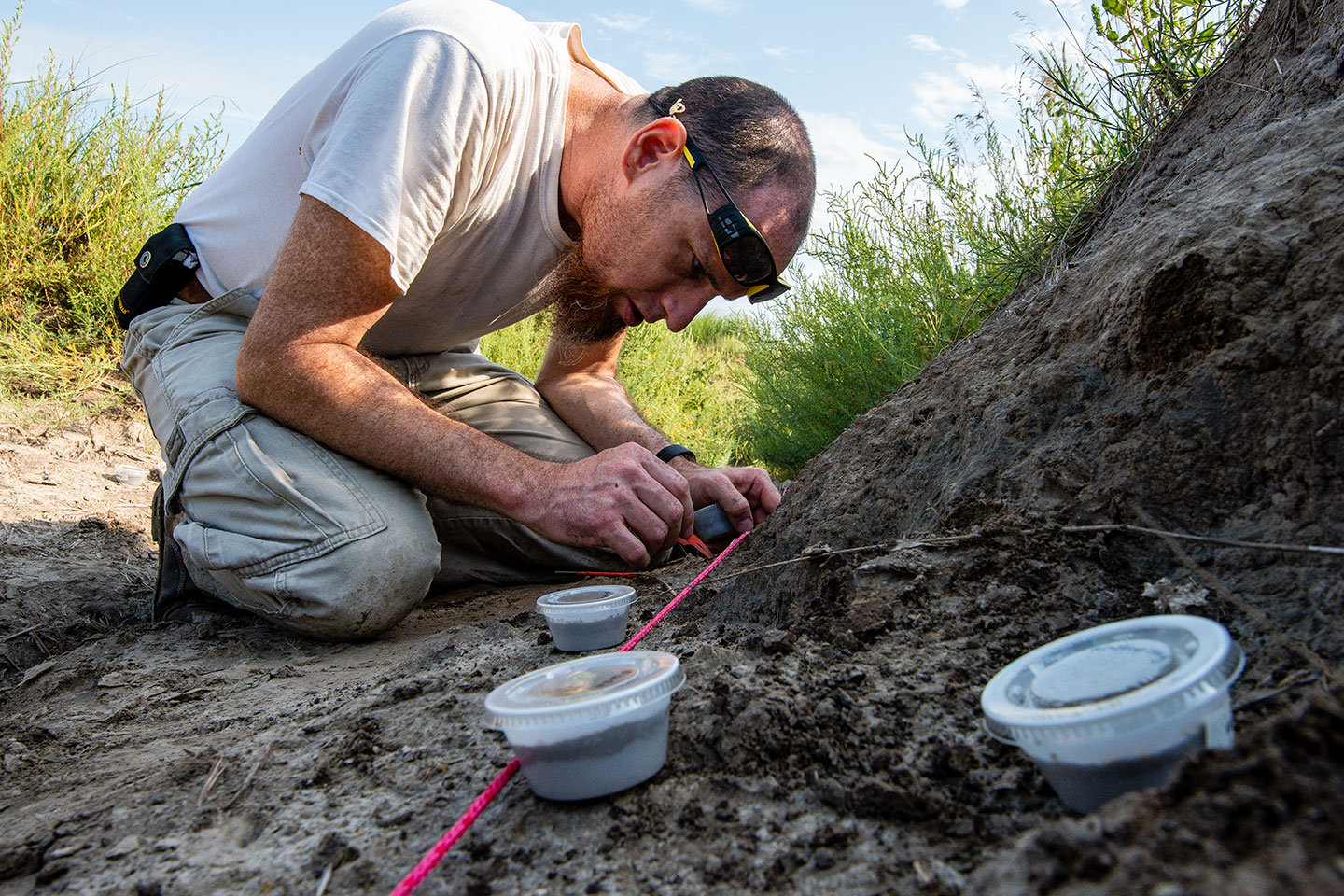Blowout penstemon
Status: Endangered

Identification
Blowout penstemon (Penstemon haydenii), also known as Hayden’s penstemon, is a perennial plant (1-2 feet tall) with waxy, greenish-blue leaves and stems that curve upward. The leaves are 3-5 inches long by 1-3 inches wide. Flowers appear in clusters with 4-6 pale to dark lavender long, tubular flowers each. The flowers also have dark nectar lines with golden hairs near the tip to guide insects to the nectar.
Range
Historically, blowout penstemon was thought to be scattered throughout the central part of the Sandhills in Nebraska. Blowout penstemon are now only found in a few counties in the Sandhills region of north central Nebraska and the northeastern Great Divide Basin in Carbon County, Wyoming.

Habitat
Blowout penstemon is found only in open sand habitats, called blowouts, in the Sandhills of north-central Nebraska and the Great Divide Basin in Wyoming. Blowouts are wind excavated depressions on dune tops and often on northwestern exposures. Heavy livestock grazing, fire or drought, singly or in combination, can remove the protective grass cover from dunes. Historically, lightening- and Native American-set fires frequently burned through the Sandhills. Large bison herds also grazed the region. Both fire and grazing removed grass cover and exposed the sand to winds. When the sand was exposed to wind, blowouts formed leaving large, barren depressions.
Along with blowout grass, lemon scurfpea and a few other plant species, blowout penstemon was often one of the first species to establish in newly formed blowouts. Blowout penstemon is a poor competitor, because of this, it is slowly eliminated as blowouts heal and other plant species begin to fill in.
Blowouts have decreased dramatically in abundance since the time of settlement. With the control of wildfires and more controlled grazing, areas of bare sand are today uncommon in the Sandhills. Because of this, blowout penstemon cannot compete in the well-established Sandhills grasslands.
Reproduction
Although, blowout penstemon does produce seeds, it primarily reproduces by rhizomes, which are underground stems that bear roots and whose buds bear new above-ground shoots. These rhizomes also provide anchorage in the unstable sands.
Growth begins in late March or early April. Buds form on the lower stems from the previous year. The species blooms from mid-to-late-May, through June and sometimes into July. Individual flowers may stay in bloom for 5 to 9 days. Plants typically do not flower until their second or third year.
Yet, the blowout penstemon has a relatively short lifespan of six to eight years due to the species’ adaptation to constantly moving sand habitat.
The large showy flowers have a strong persistent fragrance that lures several kinds of pollinators, including mason bees, leafcutter bees, some wasps, ants, beetles and butterflies. Mature fruits split open in late August to September, and seeds fall to the ground throughout the fall and winter. Flowers may produce capsules with 14-35 brown to black seeds.
Individual plants may produce 1,400 to 1,500 seeds, but typically only 500-600 seeds are actually viable.
Both wind and animals help the seeds disperse to new areas. However, naturally occurring seedlings are rare as blowouts are few and far between in the Sandhills today.
Population status
Blowout penstemon was thought to be extinct by 1940, but was later re-discovered in 1968. At the time of federal listing, blowout penstemon was known to exist in only six population centers in four counties in the Nebraska sandhills. Approximately 7,000 plants occurred on less than 25 total acres scattered throughout the Sandhills. Improved range management practices which promote blowout healing, were a major cause of the species decline in Nebraska and is still the case today. The Nebraska Game and Parks Commission listed blowout penstemon as a state endangered species in 1986. The species was listed as a federal Endangered Species in 1987.
Management and outlook
Over the last 20 years, blowout penstemon populations have been enhanced by the introduction of greenhouse grown seedlings into blowouts. This practice has not only increased plant numbers, but also created new populations to expand the range.
Currently, 32 blowout penstemon populations occur in the Sandhills region of Nebraska (10 native sites and 22 introduced populations). However, continual transplanting is necessary in order to sustain the populations at the Nebraska enhanced sites. Also, continual maintenance of the blowouts themselves is necessary since without disturbances, the blowouts stabilize and other species quickly grow, crowding out the blowout penstemon.
Despite conservation strategies to increase population numbers and the range of the species in Nebraska, two factors have continued to hamper these efforts: 1) loss of blowout habitat due to the stabilization of sand dunes 2) lack of habitat management that creates or maintains blowouts on conservation lands. Additionally, threats to the species include: drought, livestock trampling, livestock grazing, over-collection, off-road vehicles (ORVs), construction projects, pesticides, and natural outbreaks of the pyralid moth.
Active management such as controlled fire and grazing management to destabilize healing blowout habitat is necessary to ensure adequate quantity and distribution of blowout penstemon habitat for the long-term existence of the species.
Conservation help
Future actions have been outlined to assist states and agencies to better conserve and recover the blowout penstemon. Some action items include:
• Revise and update the recovery plan to reflect the best scientific and commercial information available.
• Continue research regarding life history.
• Conduct annual monitoring of both native and transplanted blowout penstemon populations.
• Investigate ways to maintain blowout habitat and determine which management practices increase the longevity of high-quality penstemon habitat.
References
Fritz, et al. 1992. Blowout Penstemon (Penstemon haydenii) Recovery Plan. U.S. Fish and Wildlife Service, Denver, Colorado. 40 pp.
Kottas, K.L. 2008. Life history and modeling of an endangered plant, Penstemon haydenii. Ph.D. Dissertation. University of Nebraska, Lincoln. 282 pp.
Stubbendieck, J. T.R. Flessner, and R.R. Weedon. 1989. Blowouts in the Nebraska Sandhills: The habitat of Penstemon haydenii. In Proceedings of the Eleventh North American Prairie Conference, ed. T.B. Bragg and Stubbendieck, 223-25. Lincoln, NE: University of Nebraska-Lincoln.
Stubbendieck, J., K.L. Kottas, and J.B. Fitzgerald. 2007. Transplanted seedlings enhance populations of endangered blowout penstemon (Nebraska). Ecological Restoration 25(2): 223-224.
U.S. Fish and Wildlife Service. 2012. Blowout Penstemon (Penstemon haydenii) 5-Year Review: Summary and Evaluation. 43 pp.
This pamphlet, is one of a series of pamphlets about Nebraska’s rare species. To learn more about Nebraska’s rare species, please visit rarespecies.nebraska.gov. Copyright 2013. Published by the Nebraska Game & Parks Commission with funds from the Nebraska Environmental Trust.
NOTE: New data of the occurrence and distribution of this species are being collected constantly and some of the information in the pamphlet may be outdated. The information in this pamphlet should be used for a general understanding of the species and not as the sole source of range location for any report, project, regional or local planning, or for environmental impact assessments. For current information on this species, please contact the Nebraska Game & Parks Commission, Wildlife Division.




